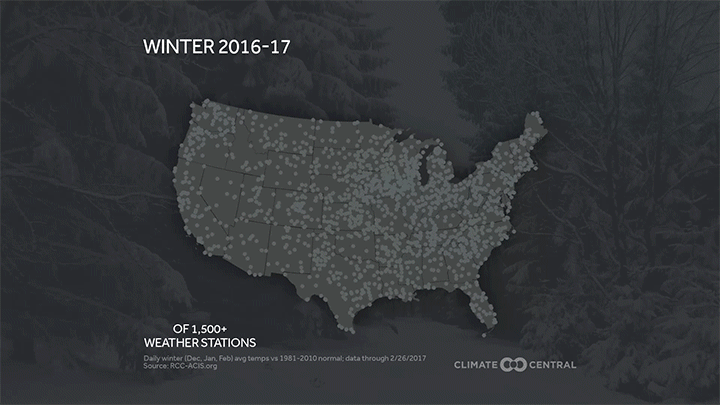




This was one of the 10 warmest winters on record for many spots in the U.S. east of the Great Plains; some of the warmest areas relative to average were southeast Texas, the Ohio and Tennessee Valleys, and Florida. Only the Northwest was substantially cooler than average for the winter. Of the 154 stations in our Climate Matters network that we analyzed:
We also looked at the percentage of days this winter that were above normal in those markets and found the highest frequency of above normal temperatures this winter was in Florida, which the Climate Prediction Center forecast to have increased odds of a warm winter. More than 80% of the days were above normal in Miami, Orlando, and Tampa this winter.
We also performed a broader analysis on 1,515 stations in the U.S. to see how their winters related to average. The results were similar to the smaller set of stations in the Climate Matters network. In the broader analysis, we found:
February was especially hot. The ratio of record highs to record lows for the month was phenomenal. The preliminary numbers from NOAA indicate:
This February’s lopsided ratio of record highs vs. record lows is an extreme example of what to expect in a warming world. The ratio of record highs compared to record lows has been increasing every decade since the 1970s. So far through the 2010s, record highs are outpacing lows more than 2-to-1. If greenhouse gas emissions continue on their current trend, the ratio could reach 15-to-1 by mid-century.
For percentage of days above/below normal, DEC-FEB temperatures through 2/26 were retrieved. For percentage of days above/below normal, temperatures through 2/26 were retrieved. Each day was then classified as above, below, or equal to the 1981-2010 normal.
For the nationwide analysis, rankings were determined by comparing the average temperature for the same period for all years in the period of record. Only years with more than 90% of the days reported were included.
Record ratios determined from NOAA/NCEI Daily Weather Records as of Feb. 27 and ongoing calculations from Guy Walton.
